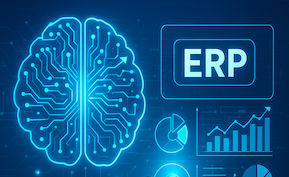Artificial Intelligence
ERP
Natural Language ERP: How to Query Your Business Data Like ChatGPT

Natural language processing represents the most significant advancement in enterprise software user experience since the introduction of graphical interfaces. Modern AI ERP systems enable business users to interact with complex enterprise data using conversational language, eliminating the need for technical expertise or specialized training to access critical business intelligence.
Understanding Natural Language ERP
Traditional ERP Data Access:
- Complex report writers requiring technical skills
- Predetermined reports with limited customization options
- SQL queries demanding database knowledge
- Rigid navigation through multiple screens and menus
- Dependence on IT resources for data access and custom reporting
Natural Language ERP Revolution:
- Conversational interaction using everyday business language
- Instant access to any business data through simple questions
- Context-aware responses understanding business relationships
- Autonomous report generation based on verbal or written requests
- Self-service analytics eliminating IT bottlenecks
Core Natural Language Capabilities
Conversational Business Intelligence
Simple Data Queries:
- “What were our sales last month?”
- “Show me inventory levels for Product X”
- “Who are our top 10 customers by revenue?”
- “What’s our current cash position?”
Complex Analytical Questions:
- “Compare this quarter’s sales performance to the same period last year by product category and region”
- “Analyze customer churn patterns and identify common characteristics of customers who cancelled in the last six months”
- “What’s the correlation between marketing campaign spending and lead generation across different channels?”
- “Predict next quarter’s demand for our top products based on historical trends and current pipeline”
Contextual Understanding: The AI understands business context and relationships, allowing for follow-up questions without repeating specifications:
- Initial question: “Show me sales by region for Q3”
- Follow-up: “Now break that down by product line”
- Additional detail: “Which sales reps had the best performance in the Northeast?”
Advanced Natural Language Features
Multi-System Data Integration: Natural language queries can access data across multiple business systems:
- “Compare our inventory levels with outstanding sales orders and show potential stockout risks”
- “Analyze customer support tickets alongside sales performance to identify service impact on revenue”
- “Show me project profitability including time tracking, expenses, and invoicing data”
Predictive Question Processing: AI anticipates information needs and provides comprehensive responses:
- Question: “How are we doing this month?”
- Response includes: Revenue vs. target, key performance indicators, trend analysis, exception alerts, and recommended actions
Autonomous Report Generation:
- “Create a monthly executive dashboard showing financial performance, operational metrics, and customer satisfaction”
- “Generate a compliance report for the FDA including all required documentation and certifications”
- “Prepare a board presentation on Q3 performance with visualizations and key insights”
Practical Implementation Examples
Sales and Customer Management
Natural Language Sales Queries:
- “Which customers haven’t ordered in the last 90 days and what was their historical purchase pattern?”
- “Show me sales pipeline by stage and highlight deals at risk of not closing this quarter”
- “Analyze win/loss ratios by competitor and identify factors that improve our success rate”
- “Create a territory analysis showing sales performance, market potential, and resource allocation”
Customer Intelligence Questions:
- “Who are our most profitable customers and what products do they buy most frequently?”
- “Identify customers with declining purchase patterns and recommend intervention strategies”
- “Analyze customer satisfaction scores and correlate with sales team performance and product quality metrics”
- “Predict which prospects are most likely to convert based on engagement patterns and demographic data”
Financial Management and Reporting
Financial Analysis Queries:
- “Explain the variance between budgeted and actual expenses by department for this quarter”
- “Show me cash flow projections for the next six months based on current receivables and payables”
- “Analyze gross margin trends by product line and identify factors driving changes”
- “Create a profitability analysis by customer segment including revenue, costs, and service expenses”
Regulatory and Compliance Questions:
- “Generate all required financial statements for the quarterly SEC filing”
- “Show audit trail documentation for all journal entries over $10,000 this year”
- “Analyze internal controls effectiveness and identify potential risk areas”
- “Prepare tax documentation showing deductible expenses by category and supporting documentation”
Operations and Supply Chain
Inventory and Supply Chain Queries:
- “Which products are at risk of stockout in the next 30 days based on current sales velocity?”
- “Analyze supplier performance including delivery times, quality metrics, and cost trends”
- “Show me demand patterns for seasonal products and recommend optimal inventory levels”
- “Identify slow-moving inventory and calculate carrying costs for liquidation analysis”
Production and Manufacturing Questions:
- “What’s our overall equipment effectiveness and which machines need attention?”
- “Analyze production quality trends and identify root causes of defect increases”
- “Show me capacity utilization by production line and recommend optimization strategies”
- “Predict maintenance requirements based on equipment usage patterns and historical data”
Industry-Specific Natural Language Applications
Manufacturing Natural Language Examples
Production Intelligence:
- “Show me real-time production status across all lines and highlight any bottlenecks or delays”
- “Analyze equipment downtime patterns and predict which machines are likely to fail next”
- “Compare actual production costs to standard costs by product and identify variance drivers”
- “What’s the impact of quality issues on production throughput and customer satisfaction?”
Supply Chain Optimization:
- “Which suppliers are causing delivery delays and how does this affect our production schedule?”
- “Analyze raw material price trends and recommend optimal purchasing strategies”
- “Show me the most critical components for production continuity and their supply risk levels”
- “How do weather patterns and economic indicators affect our supply chain performance?”
Distribution and Wholesale Applications
Inventory Intelligence:
- “Which products should we stock more of based on sales velocity and market trends?”
- “Analyze inventory turnover by location and identify optimization opportunities”
- “Show me products with high return rates and their impact on profitability”
- “Predict seasonal demand patterns and recommend inventory pre-positioning strategies”
Customer and Market Analysis:
- “Which market segments are growing fastest and how should we adjust our product mix?”
- “Analyze customer buying patterns and identify cross-selling opportunities”
- “Show me geographic sales performance and recommend territory expansion strategies”
- “How do pricing changes affect demand patterns across different customer segments?”
Professional Services Applications
Project Intelligence:
- “Show me project profitability analysis including time, expenses, and resource costs”
- “Which projects are at risk of going over budget and what factors are driving overruns?”
- “Analyze resource utilization across all projects and identify optimization opportunities”
- “Predict project completion dates based on current progress and resource availability”
Client Relationship Management:
- “Which clients generate the highest margins and what services do they value most?”
- “Identify clients at risk of reducing engagement and recommend retention strategies”
- “Analyze proposal win rates by service type and client characteristics”
- “Show me market opportunities based on client industry trends and needs analysis”
Implementation Best Practices
User Training and Adoption
Getting Started with Natural Language Queries:
Week 1: Basic Questions
- Start with simple, factual questions about familiar data
- Practice asking the same question in different ways
- Learn to interpret AI responses and ask follow-up questions
- Understand when AI needs clarification or additional context
Week 2: Analytical Thinking
- Move beyond simple facts to analytical questions
- Practice comparative analysis and trend identification
- Learn to ask “why” and “what if” questions
- Explore cause-and-effect relationships in business data
Week 3: Advanced Applications
- Combine multiple data sources in single queries
- Use predictive and prescriptive analytics features
- Create custom reports and dashboards through conversation
- Develop industry-specific query patterns and templates
Query Optimization Techniques
Effective Natural Language Query Structure:
Be Specific About Context:
- Instead of: “Show me sales”
- Better: “Show me sales by region for the last quarter compared to the same period last year”
Provide Clear Time Frames:
- Instead of: “Analyze customer behavior”
- Better: “Analyze customer purchase behavior over the past 12 months, identifying trends and seasonal patterns”
Specify Desired Format:
- Instead of: “Give me financial performance”
- Better: “Create a visual dashboard showing financial performance with charts for revenue, expenses, and profit by month”
Include Business Context:
- Instead of: “Why are sales down?”
- Better: “Analyze factors contributing to decreased sales in the Northeast region, considering seasonality, competition, and product mix changes”
Advanced Natural Language Features
Predictive Analytics Through Conversation
Forecasting Questions:
- “Predict next quarter’s revenue based on current pipeline and historical conversion rates”
- “What inventory levels should we maintain to achieve 95% service levels while minimizing carrying costs?”
- “Forecast cash flow for the next six months including accounts receivable collection patterns”
- “Predict which customers are likely to increase their spending based on engagement patterns”
Scenario Analysis:
- “What would happen to our profitability if raw material costs increased by 15%?”
- “How would a 10% price increase affect demand across different customer segments?”
- “Analyze the impact of adding a new product line on overall business performance”
- “What’s the optimal resource allocation to maximize project profitability?”
Autonomous Business Intelligence
Proactive Insights: Modern AI ERP systems don’t wait for questions—they proactively provide insights:
- “I noticed customer satisfaction scores declined in the Midwest region. Here’s an analysis of contributing factors and recommended actions.”
- “Sales velocity for Product X has decreased 25% this month. Analysis shows correlation with competitor pricing changes and customer feedback.”
- “Cash flow projections indicate potential shortage in 60 days based on current receivables patterns. Here are recommended acceleration strategies.”
Exception Management:
- Automatic alerts for unusual patterns or performance deviations
- Intelligent escalation based on business impact and urgency
- Recommended actions based on similar historical situations
- Continuous monitoring and adaptive learning from business patterns
Future Evolution of Natural Language ERP
Emerging Capabilities
Voice Integration:
- Hands-free operation through voice commands and responses
- Integration with smart speakers and mobile devices
- Natural conversation flow for complex analytical discussions
- Multi-modal interaction combining voice, text, and visual elements
Contextual Intelligence:
- Understanding of user role, responsibilities, and information needs
- Personalized insights and recommendations based on user behavior
- Adaptive learning from user interactions and feedback
- Proactive information delivery based on business context and timing
Collaborative Intelligence:
- Multi-user analytical sessions and shared insight development
- Integration with collaboration platforms for team-based analysis
- Automatic documentation and sharing of insights and decisions
- Collective organizational learning and knowledge management
Measuring Natural Language ERP Success
User Adoption Metrics
Usage Frequency:
- Number of natural language queries per user per day
- Complexity progression from simple to advanced questions
- Percentage of users actively using conversational features
- Time saved compared to traditional reporting methods
Query Effectiveness:
- Successful query resolution rate without human intervention
- User satisfaction with AI responses and insights
- Accuracy of AI interpretations and recommendations
- Reduction in IT support requests for reporting and data access
Business Impact Measurement
Decision-Making Speed:
- Time from question to actionable insight
- Reduction in report request and delivery cycles
- Faster identification of business opportunities and risks
- Improved responsiveness to market changes and customer needs
Insight Quality and Value:
- Number of actionable insights generated through natural language queries
- Business value of decisions supported by AI-generated analysis
- Accuracy of predictions and forecasts compared to actual outcomes
- User confidence in AI-generated insights and recommendations
Conclusion
Natural language ERP represents a fundamental transformation in how business users interact with enterprise data and systems. By eliminating technical barriers and enabling conversational access to business intelligence, organizations can democratize data access and accelerate insight-driven decision-making.
The key to success lies in systematic user training, thoughtful query development, and continuous optimization based on actual usage patterns and business outcomes. Organizations that master natural language ERP capabilities gain significant competitive advantages through faster, more informed decision-making and enhanced operational agility.
As AI technology continues evolving, natural language interaction will become the primary interface for business software, making early adoption and expertise development critical for sustained competitive advantage.






